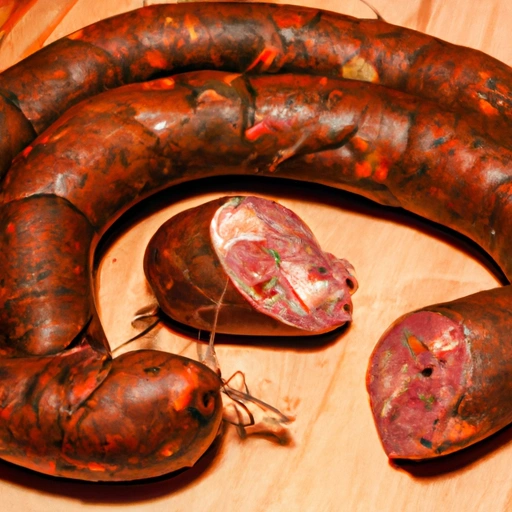Chouriço
Description

Chouriço, also known as chouriça or chorizo in Spanish, is a type of pork sausage that hails from the Iberian Peninsula, which includes Portugal and Spain. Its distinctive smoky flavor, derived from the pimentón (smoked paprika), and its versatility make it a beloved ingredient in various culinary traditions. Depending on the region, chouriço can range from mildly spicy to quite hot, and it often includes other seasonings such as garlic, herbs, and vinegar.
Common uses
Chouriço is commonly used to enhance flavor in stews and soups, served grilled or fried as a standalone dish, or sliced and eaten as part of a charcuterie board. It is also a popular topping for pizza and is frequently included in sandwiches. In Portuguese and Spanish cultures, chouriço is often a key ingredient in traditional dishes such as feijoada and paella.
Nutritional value
Calories
A typical serving of chouriço (1 ounce or about 28 grams) contains approximately 120 calories.
Protein
Chouriço provides about 7 grams of protein per serving, making it a good source of this macronutrient.
Fat
The fat content in chouriço can be quite high, with about 10 grams per serving, which includes saturated fats.
Carbohydrates
Chouriço is low in carbohydrates, typically containing less than 1 gram per serving.
Vitamins
Chouriço contains some B-vitamins, particularly vitamin B12, which is important for brain health and maintaining the nervous system.
Minerals
As a meat product, chouriço is a source of minerals such as zinc, iron, and phosphorus.
Health benefits
While chouriço is not typically known for its health benefits due to its high fat and sodium content, it does provide a source of protein and important vitamins and minerals. Consumed in moderation, it can be part of a balanced diet.
Potential risks
The high levels of fat, particularly saturated fat, along with sodium in chouriço, can contribute to cardiovascular issues if consumed in excess. Additionally, some studies suggest a link between processed meats and an increased risk of certain cancers.
Common recipes
Chouriço is featured in a variety of recipes such as the Portuguese caldo verde (a green soup), Spanish chorizo al vino (chorizo in wine), and as an integral component of the Brazilian and Portuguese feijoada (a bean stew).
Cooking methods
It can be grilled, fried, simmered, or baked. Chouriço is also often sliced and eaten raw if it is a cured variety.
Pairing with other ingredients
Chouriço pairs well with robust flavors such as red wines, starchy foods like potatoes and rice, and complements the taste of legumes and green vegetables.
Summary
Chouriço is a flavorful pork sausage with a rich history in the Iberian Peninsula. Its smoky, spicy taste and versatility make it popular in a wide range of dishes. While offering some nutritional benefits, it should be enjoyed in moderation due to its fat and sodium content. Chouriço's culinary uses are vast, making it a cherished ingredient in many traditional and modern recipes.